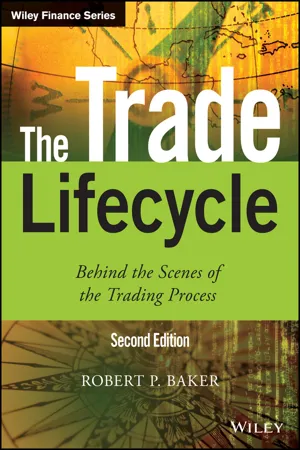
- English
- ePUB (mobile friendly)
- Available on iOS & Android
About This Book
Drive profit and manage risk with expert guidance on trade processing
The Trade Lifecycle catalogues and details the various types of trades, including the inherent cashflows and risk exposures of each. Now in its second edition, this comprehensive guide includes major new coverage of traded products, credit valuation adjustment, regulation, and the role of information technology. By reading this, you'll dissect a trade into its component parts, track it from preconception to maturity, and learn how it affects each business function of a financial institution. You will become familiar with the full extent of legal, operational, liquidity, credit, and market risks to which it is exposed. Case studies of real projects cover topics like FX exotics, commodity counterparty risk, equity settlement, bond management, and global derivatives initiatives, while the companion website features additional video training on specific topics to help you build a strong background in this fundamental aspect of finance.
Trade processing and settlement combined with control of risk has been thrust into the limelight with the recent near collapse of the global financial market. This book provides thorough, practical guidance toward processing the trade, and the risks and rewards it entails.
- Gain deep insight into emerging subject areas
- Understand each step of the trade process
- Examine the individual components of a trade
- Learn how each trade affects everything it touches
Every person working in a bank is highly connected to the lifecycle of a trade. It is the glue by which all departments are bound, and the aggregated success or failure of each trade determines the entire organization's survival. The Trade Lifecycle explains the fundamentals of trade processing and gives you the knowledge you need to further your success in the market.
Frequently asked questions
Part One
Products and the Background to Trading
Chapter 1
Trading
1.1 How and why do people trade?
- Require more or less of a productWe go shopping because we need things. The same is true of financial products. One person buys something that another person has in surplus and is prepared to sell.
- To make profitIf someone anticipates that he can buy for less than he can sell and has the ability to hold a product long enough to take advantage of the price differential, he trades.
- To remove riskSometimes we need protection. We are worried that future events may cause our position to deteriorate and we therefore buy or sell to reduce our risk. The ship is safe, fully loaded in port today, but how will it fare exposed to the open sea tomorrow?
1.2 Factors affecting trade
Product appetite
Risk appetite
Exposure
| Item | Exposure for buyer (Company A) | Exposure for seller (Company B) |
| EUR JPY | Increased Decreased | Decreased Increased |
1.3 Market participants
Producer
Consumer
Speculator
Table of contents
- Cover
- Series
- Title Page
- Copyright
- Dedication
- Foreword from the First Edition
- Foreword to the Second Edition
- Preface
- Acknowledgements
- About the Author
- Part One: Products and the Background to Trading
- Part Two: The Trade Lifecycle
- Part Three: What Really Happens
- Part Four: Behind the Scenes
- Part Five: Summary of Risks
- Appendix A: Operational Risks
- Appendix B: Human Risks
- Appendix C: Control Risks
- Appendix D: Processing Risks
- Appendix E: Organisational Risks
- Recommended Reading
- Index
- EULA